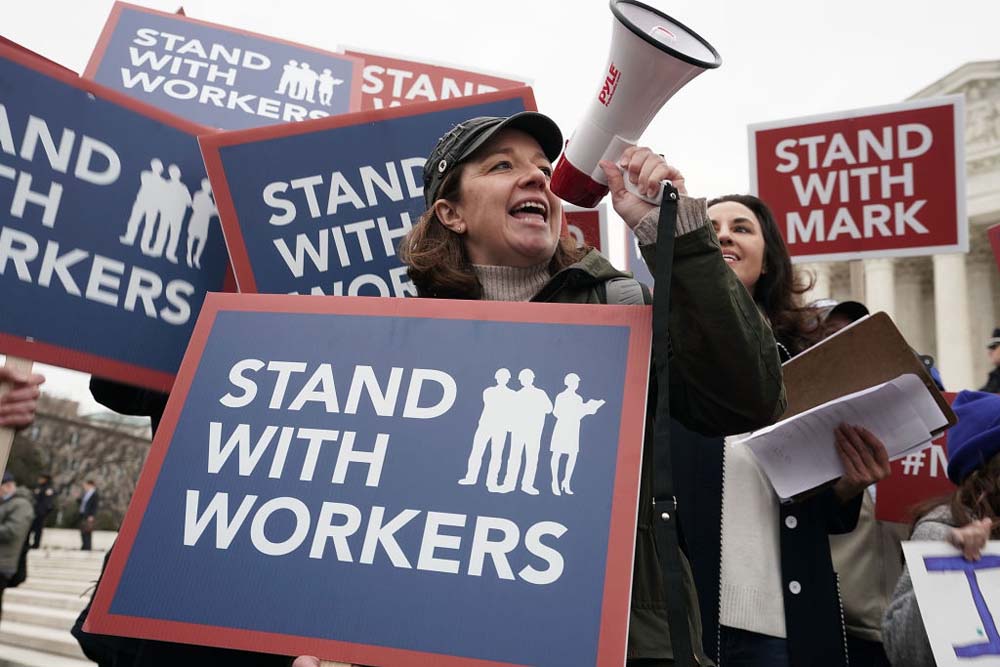Blue-state officials make legal moves to shore up an important source of political support.
Whatever happened to public-sector unions? Justice Elena Kagan warned of “large scale consequences . . . involving millions of employees” in her dissent last year from the Supreme Court’s ruling in Janus v. Afscme. Yet according to the Bureau of Labor Statistics, unions in state and local government only lost 54,000 members, falling from 6.244 million to 6.19 million in 2018—a decline of less than 1%.
So much for Justice Kagan’s claim that unions couldn’t survive as effective bargaining partners without collecting mandatory “agency fees” from employees who declined to join. The reality is that public unions in the 22 states affected by Janus started from positions of strength. State and local government unionization rates have been between 33% and 38% since the early 1980s. To remain influential, all public unions need to do is retain their existing members and do a decent job recruiting new hires.
But that’s only part of the story. State governments from New York to California have given public unions a big leg up since Janus. Even before the court’s 5-4 ruling against Afscme, eight of the 22 affected states passed laws to shield unions from the full impact of the court’s decision.
The states with the largest public unions led the charge. In New York, where nearly 70% of public employees are covered by union contracts, Gov. Andrew Cuomo began with an executive order to prevent public entities from sharing their employees’ contact information with groups seeking to inform public workers of their newly recognized rights under Janus. The governor framed his order as protecting workers from “harassment and intimidation,” but it really guarded union funds. At the time, the Freedom Foundation and other conservative nonprofits had already launched campaigns in other states to explain to workers how they could now opt out of filling union coffers.
Strong public-union states have also passed new laws to help labor leaders organize and recruit new members. Laws in New York and California now give unions access to employees’ contact information. They also require new hires to meet with union representatives for up to an hour so they can pitch membership. Similar laws have also been passed in New Jersey, Maryland and Washington.
Some of these states also prohibit government employers from discouraging workers from joining unions. California law now states that a public employer “shall not deter or discourage public employees from becoming or remaining members of an employee organization.” Such language may imply that government employers can’t even tell workers how to opt out of union membership. New Jersey requires public employers to reimburse unions for lost dues if they are found to have violated a similar provision.
These measures encourage union communication with public employees, but make it less likely that workers will hear about their rights under the law—or other outside perspectives on the merits of public-union membership. Other measures stipulate that workers can only revoke their union membership during specific times each year. These “windows,” sometimes as short as 10 business days, are often tied to the date a person was hired or signed a union card.
Finally, to push workers toward joining or remaining in unions, some of the new laws limit union services to members only. For example, Rhode Island allows police unions to stop representing nonmembers in grievance cases. New York State United Teachers has used new state legislation to strip all nonunion members, whom they still represent in labor negotiations, of life insurance.
All these pro-union changes have sparked multiple lawsuits. Nonunion employees seeking to recover the agency fees collected from their paychecks before the court’s decision have also filed lawsuits in nearly all federal district courts. If these retroactive-refund suits are successful, they could cost public unions an estimated $150 million.
Public workers in Maine, Ohio and Minnesota are challenging a union’s power to be the exclusive bargaining representative. Petitioners in one case have already appealed to the U.S. Supreme Court. If they win, individual employees or groups of employees would be allowed to negotiate directly with management.
If the unions lose these legal battles or find their treasuries depleted, don’t be surprised if some state legislators embrace Harvard Law professor Benjamin Sachs’ idea to fund public unions directly with tax dollars. The Hawaii Senate is already considering such a bill.
As the Journal has reported, with less money, unions have scaled back wasteful spending and are learning to “compete and operate” without squeezing agency fees out of nonmembers. While Janus may weaken public unions in the long run, they are poised to remain important political players—with help from their friends in state government.
This piece originally appeared at The Wall Street Journal
______________________
Daniel DiSalvo is a senior fellow at the Manhattan Institute, an associate professor of political science at the City College Of New York (CUNY), and author of the new report, Public Sector Unions After Janus. Follow him on Twitter here.
This piece originally appeared in The Wall Street Journal
